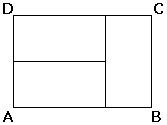Outline Mathematics
Geometry
Three Congruent Rectangles
A geometry problem that requires a little logic and algebra:
|
Reactangle ABCD contains three small congruent rectangles. If the smaller dimension of one of the small rectangles is 5 units, what is the area of rectangle ABCD in square units? |
|Up| |Contact| |Front page| |Contents| |Geometry|
Copyright © 1996-2018 Alexander Bogomolny
Solution
|
Reactangle ABCD contains three small congruent rectangles. If the smaller dimension of one of the small rectangles is 5 units, what is the area of rectangle ABCD in square units? |
We may make three observations:
- Sides AD and BC,AD,AB,BC,CD of the big rectangle are equal.
- BC also serves as the big,big,small side of the small rectangle.
- (Looking at AD,) Two small sides of a small rectangle fit exactly in the small,big,small side of the big rectangle.
From #3, the small side of the big rectangle is twice,equal,twice,thrice the small side of the small rectangle, i.e., 10,5,10,20,30 units. From #2 (and #1), the big side of the small rectangle equals 10 units. The area of a rectangle equals the product of its sides. Therefore, the area of a small rectangle equals
Let's do this in a little more general way. Let x and y denote the small and the large dimensions of the small rectangle. This makes the area of the small rectangle xy,x + y,2x + y,3xy,xy and the area of the big rectangle 3xy. On the other hand, the small side of the big rectangle is 2x,x,2x,3x,4x whereas its big side measures
| 3xy = 2x·(x + y). |
If x = 0, the problem degenerates into a case that requires no calculations. The big rectangles fills zero area as does a small rectangle. So assume
| 3y = 2(x + y) = 2x + 2y, |
which shows that
| y = 2x. |
For x = 5, y = 10,5,10,20,30 and we are done.
References
- G. Lenchner, Math Olympiad Contest Problems For Elementary and Middle Schools, Glenwood Publications, NY, 1997
|Up| |Contact| |Front page| |Contents| |Geometry|
Copyright © 1996-2018 Alexander Bogomolny
71535727

